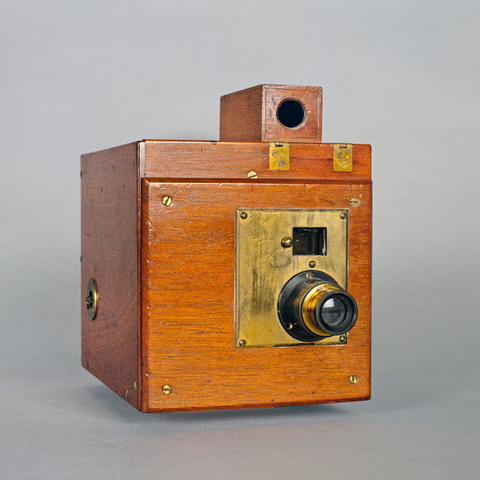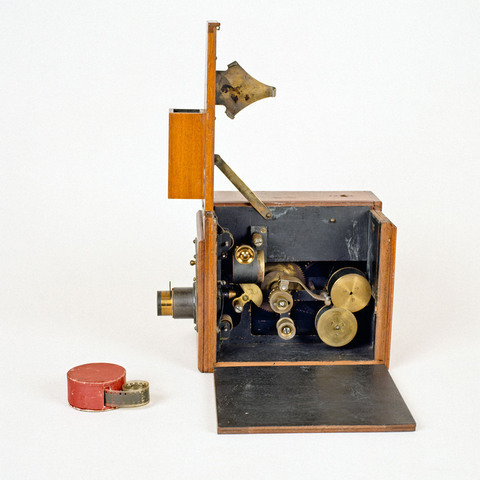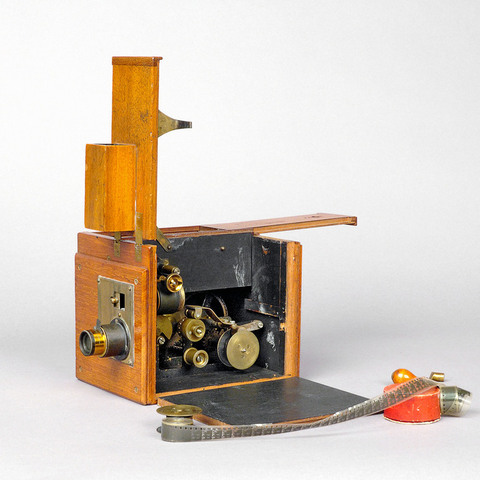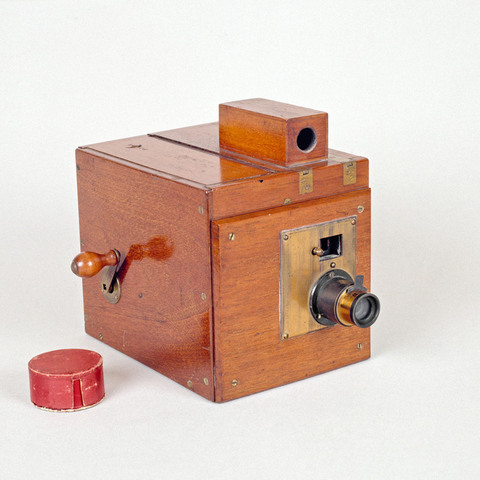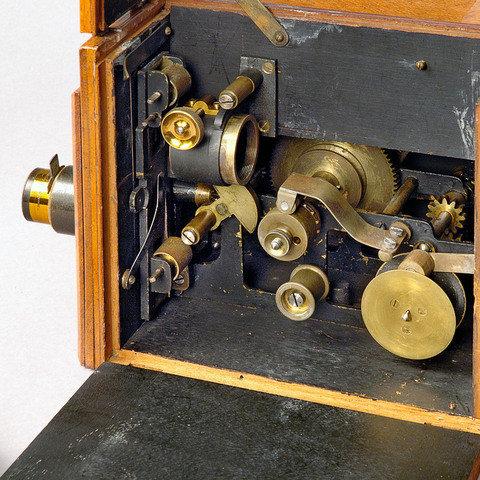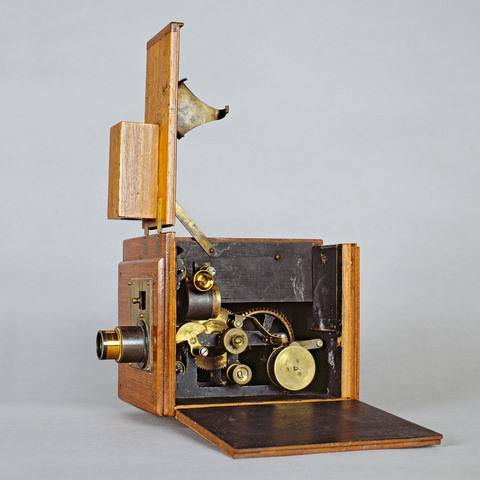Caméra réversible film 17 mm
Fiche détaillée
Type de l'appareil
entraînement du film 17 mm par came battante ; un débiteur denté ; deux bobines en cuivre à l'intérieur de la boîte ; viseur extérieur ; logement pour accessoire sur le dessus de l'appareil ; deux objectifs pour la prise de vues et la projection (ce dernier manquant)
Auteurs
Acres Birt
Wrotham Cottage, Hadley, Barnet, Hertford
Fabricants
Northern Photographic Works LTD
Londres, Nesbit's Alley, High Street, Barnet
Utilisateurs
Acres Birt
Wrotham Cottage, Hadley, Barnet, Hertford
Distributeurs
Informations non disponibles
Sujet du modèle
Informations non disponibles
Objectif
Ross n° 57 573, 2,5 cm Ø
Taille de l'objet
Ouvert :
Informations non disponibles
Fermé :
Longueur : 24.5 cm
Largeur : 15 cm
Hauteur : 20.5 cm
Diamètre :
Informations non disponibles
Taille de la boîte de transport
Informations non disponibles
Remarques
Le Birtac, caméra réversible brevetée le 9 juin 1898 par l'Anglais Birt Acres, ancien associé de Robert William Paul, est l'un des premiers appareils pour "amateur". Il utilise du film 17 mm de largeur avec deux perforations rectangulaires disposées d'un seul côté de l'image.
"From first to last, in taking negatives with the Birtac, it worked without any hitch, except that the black strip of protective paper which, at the end of an exposure, should wind round the film, and shield it from the light, was at times apt to tear away at its junction with the celluloïd this made it advisable to change the films, not in broad daylight, but with a cloth thrown over the camera. Its is, however, only fair to say that others who use the camera have not found the above liability of the black paper to decome detached. The charging ot the Birtac [...] may be effected within about one minute. [...] One point should be specially borne in mind when turning the handle, and that is to keep the motion as regular as possible. [...] Turning the handle at about three times per second, it takes nearly one minute to use up the film. [...] Developing the film. [...] The image should come up slowly (two or three minutes), and should finish in twelve to twenty minutes. [...] Instead of pyro-soda, metol-hydroquinone may be used, one advantage of the latter being that two or three exposures may be successively developed with one lot of solution. The following may be used with advantage, subject to modification according to circumstances : Metol, 50 gr. ; Hydroquinone, 50 gr. ; Sulphite soda, 1 /2 oz. ; Carbonate soda, 1 oz. ; Pot. bromide, 20 gr. ; Water, 20 oz. Although a plain alum bath is sometimes necessary after fixing, it is best dispensed with, unless, through heat or other causes, frilling is feared. The Birtac experimented with was used both carefully and carelessly without its mechanism getting out of order. The lens - by Ross - even at full aperture, gave a crisp image, and, when stopped down, using the smallest diaphragm but one (the values are not marked), objects within about 15 feet were fully exposed in a good light. The film sent out by the makers developed up with ease and regularity, and was commendably free from incidental defects. Altogether the writer was much pleased with the Birtac for its substantial make and its general reliability of action, while the facility of carrying a dozen films in one's pockets, and changing them between each exposure, is very useful, when, as sometimes happens, happy subjetcs come in crowds" (Cecil M. Hepworth, Animated Photography, the ABC of the Cinematograph, London, Hazell, Watson & Viney, 1900, p. 119-125).
"Of all the apparatus marketed during 1898, none created more attention than the Birtac, a small sub-standard gauge cinematograph invented and patented by Birt Acres. It was self-contained in a wood case no bigger than a "good-sized box hand-camera", and combined the functions of camera and projector. A film 17,5 mm wide was utilised which was derived from ordinary 35 mm stock split down the middle and, as its inventor pointed out, "the apparatus was essentially one suited to drawing-room displays of small proportions, designed for a disc not greatly exceeding two or three feet, and depending upon the usual supply of house gas for its illuminant. When used as a camera, the negative was placed in the film holder attached to the underside of the top panel. It was then threaded through the machine, first over the top guide roller, then through the gate, and under a second roller and on to the sprocket-wheel. From there it passed under a third guide roller to the take-up bobbin. [...] The film was supplied on spools for daylight loading and had a length of black paper attached to the end to prevent undue exposure. The intermittent movement of the film was effected by a common dog or eccentric cam mechanism. The camera was fitted with a Ross lens and a view finder. In order to function as a projector, the top of the box was raised and the positive film placed in the same container that served for the negative. The film was threaded through the machine as previously described, but by a re-arrangement of the front panel, a projection lens was brought into service instead of the lens used for photographing. A special incandescent gas lamp was attached to the back of the instrument to provide the illumination. The complete outfit cost ten guineas (£ 10.50). Negatives 20 ft long were available at 2 s. 6 d. each and the price of processing same was 1 s. 6 d. each. If prints were required, these were supplied at 4 s. 6 d. each. Owners of the Birtac could also do their own developing and printing and for this purpose the necessary equipment was available for another two guineas (£ 2.10). To launch the new apparatus, Birt Acres gave a special demonstration before the Camera Club at Anderton's Hotel in the Strand on 26 October. Unfortunately, things did not go as well as they might, for there was some trouble with the illuminant. Apparently the pressure of the house gas was not sufficient to give a proper light and the occasion was somewhat marred by this defect. Undaunted by the setback, Acres soon set about designing a new lamp and quickly came up with a new solution to the problem. He lost no time in communicating his success and the following letter appeared in the photographic press : "Sir, I was very much disappointed to find there was practically no pressure of gas when I was giving an exhibition of my new projection machine before the Photographic Club, at Anderton's Hotel, last Wednesday night, and that consequently such good results were not obtained as I had previously secured whilst experimenting down here. However, as good generally comes out of evil, I have invented a machine which automatically provides this pressure, and affords a light superior to limelight. With this I am able to throw a brilliant image upon the screen of six feet dimensions with my little machine, and so obviate any difficulty which might have arisen owing to future purchasers having as faulty gas arrangements as the hotel above mentioned. Yours faithfully, Birt Acres. The Northern Photographic Works, Limited, Barnet, London, October 31st 1898". On the 13th of December, the Birtac was again demonstrated by its inventor, this time before the Hackney Photographic Society. [...] There is no doubt that Birt Acres believed that the Birtac would do for cinematography what the Kodak had done for still photography. [...] In reality, Birt Acres did not achieve the success of which he dreamed. No sooner had he launched the Birtac, than the Warwick Trading Company announced its own sub-standard gauge cinematograph called the Biokam. It was almost half the price of the Birtac, used a centrally perforated film (17,5 mm) and combined the functions of camera, printer, projector and snap-shot camera. Furthermore, it could be fitted to any standard optical lantern. Although the Biokam was registered as early as November, it was not until the following year that it finally appeared on the market. Even through the Biokam was to prove a greater financial success than the Birtac, this should not detract from the latter's importance, for it was after all, the first sub-standard gauge cinematograph ever made" (John Barnes, Pioneers of the British Film, London, Bishopsgate Press Ltd, 1983, p. 114-115).
Bibliographie
Cecil M. Hepworth, Animated Photography, the ABC of the Cinematograph, London, Hazell, Watson & Viney, 1900, p. 119-125.
John Barnes, Pioneers of the British Film, London, Bishopsgate Press Ltd, 1983, p. 114-115.
